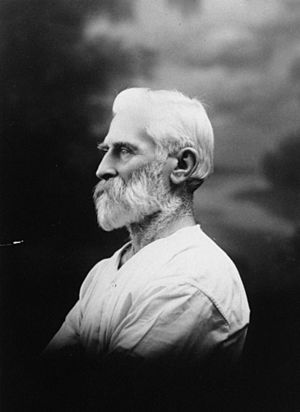Gilbert Casey facts for kids
Gilbert Stephen Casey (born 1856 – died 1946) was an important figure in Australia's early worker movements. He was a trade unionist, which means he helped organize groups of workers to improve their pay and conditions. He also believed in utopian socialism, a big idea about creating a perfect society where everyone shares resources fairly.
Contents
Gilbert Casey's Early Life
Gilbert Stephen Casey was born in 1856 in County Clare, Ireland. His father, Patrick Casey, worked as a storeman. Gilbert didn't have much formal schooling. He started working at sea, where he first learned about trade unions.
He likely moved to Queensland, Australia, in October 1883. In Australia, he worked in different jobs, including as a seaman, a bushworker, a coalminer, and a wharflabourer.
Life in New Australia
On October 14, 1883, Casey married Alice Tighe. Later, in 1895, she left him in a place called New Australia. He then married Maria Antonia Sosa, a woman from Paraguay.
Gilbert and Maria had two sons. They raised cattle at a place called La Novia. Casey also wrote letters and articles for Australian worker newspapers. For many years, he was the chief of police in New Australia. He passed away there on October 2, 1946.
Casey's Work for Workers' Rights
In February 1886, Casey joined the Queensland Maritime Council. He had helped create the Brisbane Wharf Labourers' Union the year before. In 1888, the council sent him on a trip to organize workers in several Queensland towns. He helped start the Townsville Trades and Labor Council (T.L.C.) during this trip.
As a member of the Brisbane Trades and Labour Council, Casey helped manage the Brisbane Trades Hall land. He also worked to change the council into the Australian Labour Federation (A.L.F.) in June 1889. He became a member of its main council.
Building the Australian Labour Federation
In December 1889, Casey, along with Thomas Glassey and Albert Hinchcliffe, successfully encouraged bush unions to join the A.L.F. In April 1890, Casey became a full-time organizer for the A.L.F. In just three months, he set up new unions and A.L.F. councils in towns like Maryborough, Rockhampton, Charters Towers, and Townsville. In February 1890, Casey was chosen as the first chairman for the board of trustees of Worker newspaper.
Challenges and New Ideas
After Australia faced economic problems in 1890, and workers lost big strikes like the 1890 maritime strike and the 1891 shearers' strike, Casey wanted a big general strike across Australia. Other union leaders preferred to negotiate to get workers back to their jobs. Casey's strong views sometimes caused problems.
During the shearers' strike in 1891 in Barcaldine, he faced difficulties but was later released.
Casey strongly believed in 'new unionism'. He thought it would completely change society, which he felt was unfair. After the shearers' strike failed in 1891, he found it hard to accept the A.L.F.'s support for starting the Australian Labor Party. He worried it would be easily controlled by powerful people.
The New Australia Dream
Casey became a strong supporter of William Lane's New Australia Co-operative Settlement Association. This group wanted to create a perfect society, or utopia, in South America. Casey even gave his home in Brisbane as a prize to raise money for the project. On December 31, 1893, he left with his wife and a second group of settlers on the ship Royal Tar Australia. They were headed to New Australia in Paraguay.
He stayed in the Australian colony of New Australia even after it faced problems and split. He briefly returned to Australia in 1894 to try and get more support for the colony. In 1896, he was chosen as president of the Sociedad Co-operativa Colonizadora Nueva Australia. He remained the police chief of New Australia until he died on October 2, 1946.


